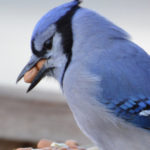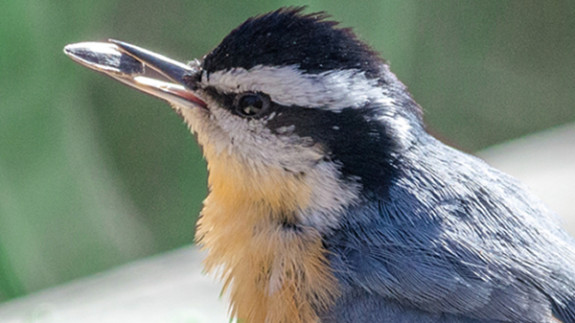Why Feed Quality Seed to Wild Birds?

Empty Calories are Lost Nourishment!
Wild birds must be efficient eaters to survive. They seek the best nutritional content available and eat their fill quickly.
For wild birds, with their fast-acting metabolism and high calorie requirements, eating anything that doesn’t contain essential protein, fat and carbohydrates is a lost opportunity for nourishment.
Premium quality seed maximizes nutrition.
Never feed bread to wild birds.
Please NEVER feed bread, crackers, popcorn or other human snack food items to birds. They contain zero nutrition, but give birds the artificial feeling that they are full. Wild birds, in particular, Chickadees, can freeze to death overnight with seemingly full stomachs. This includes all wild birds, even ducks and geese who can develop a debilitating condition called “angel wing syndrome” from the lack of nutrition.
What is Best Quality Bird Seed?
Premium bird seed is:
- Fresh! Harvested from the most recent season
- Free from pesticides
- Non-GMO
- Stored properly, free from moisture and contaminants
- Not bulked out with filler seeds
- High oil content
Bargain Seed isn’t Always the Best Deal
Not all bird seed is created equal! When feeding wild birds, think quality and value. There are reasons why that bag of mixed seed is so cheap!
Signs of inferior seed:
- Full of irrelevant filler seeds undesirable for the majority of our local wild birds. This waste will end up on the ground beneath your feeders and attract less desirable scavenger birds and worse, rodents!
- It’s old, nutrition depleted. Or rancid! Being held over from previous harvest(s) allows time for loss of nutrients and taste.
- It’s been stored improperly, exposed to moisture.
- Contains unacceptable amount of insect larvae or rodent feces.
- It’s made by the same company who makes pesticides!!! RED FLAG!!! (See this most disturbing example on the US Department of Justice website: Scott’s Miracle-Gro ‘Morning Song’ Wild Bird Seed mix, distributed nationally, knowingly violated U.S. Federal Pesticide Law and killed unknown numbers of birds.)
How to Buy and Store Premium Quality Bird Seeds
- Read the labels! Check the dates and make sure all the seed is the most recent season’s fresh crop.
- Scan the list of ingredients in seed blends before you purchase. Premium bird seed will not have fillers, such as:
- Milo
- Red Millet
- Rye
- Wheat
- Corn
- Don’t buy more than your birds can eat in a few months. (We can help you figure out how much you need for your feeders.)
- Store seed in a dry, airtight container, secure from insects or foragers.
How to Tell When Bird Seed Goes Bad
Has something about your bird seed changed since you bought it? If any of the following are present, dispose of it and buy fresh seed.
- Unpleasant smell. It should smell fresh and nutty.
- Stickiness and clumping. This means the seed is damp and in a pre-mold condition.
- Change in color or has a dullness or powdery coating.
- Evidence of insect infestation, i.e. spider-like webbing, cocoons.
Why Clean Feeders Matter
Clean Feeders are Healthy Feeders
A filthy bird feeder is unhealthy. A moldy bird feeder is dangerous! Wild birds are vulnerable to diseases caused by inhaling mold spores, among others. Keeping an eye on the cleanliness of your feeders and cleaning them quickly when needed is vital.
Before you refill a feeder, or top it off with food, remove any debris left by your guests. Make sure any remaining seed is dry and fresh. Refer back to ‘How to Tell When Bird Seed Goes Bad’ above for the signs that seed is spoiled and should be replaced.
Keeping your feeder healthy is easy! Clean feeders regularly—at least once a month, more often when feeder traffic is heavy or during prolonged wet or humid weather. Hot soapy water and a good scrub is all it needs! Here’s the basic method:
The Easiest Way to Clean Your Bird Feeder
A Routine Cleaning
- Disassemble feeder as much as possible.
- Soak in hot soapy water and scrub with a brush/scrunge sponge.
- Rinse thoroughly; until all soap is gone. Rinse again to be sure!
- Let parts dry completely.
- Reassemble feeder and fill it with fresh seed.
- Rake up and dispose of any debris beneath feeders.
When and How to Deep Clean Your Bird Feeders
What is a ‘Deep Cleaning’?
Fortunately, a deep cleaning means just adding one extra step to the regular, routine cleaning: soaking in a diluted bleach (most feeders) or, a diluted vinegar solution (wood feeders). This is sometimes necessary to thoroughly eradicate mold or bacteria that can be deadly for birds. See ‘How to Clean a Bird Feeder‘ for specific details.
If you see a sick bird at your feeder
Thankfully, there’s no salmonella outbreak currently in our area. However, if you do see a bird at one of your feeders that appears to be compromised by some type of sickness, assume that it has visited your other feeders and is possibly contagious.
This is the time to be proactive to protect the health of your other birds. Quickly take all your feeders down and throw away the old food. Do a deep cleaning of all your feeders, and refill them with fresh food.
If you see a sick bird at your bath
All birds need water for drinking and bathing, so your bird bath is likely visited by insect and fruit eaters that do not frequent your seed feeders. If you see a sick bird at one of your bird baths, take all of the baths ‘out of action’ and give them a thorough cleaning.
How to tell if a bird is sick
- “Puffed up” feathers
- Labored breathing
- Weakness, drooping wings, or an inability to stand.
- Diarrhea
- Lethargic/does not fly away when approached.
Call a wildlife rehabilitator for advice and next steps. Don’t handle or try to treat the bird yourself.
Second Chance Wildlife Center
301-926-WILD (9453)
Maryland Department of Natural Resources
Call 1-877-463-6497 or see Licensed Wildlife Rehabilitators
Montgomery County Animal Control
(240) 773-5900
When and how to clean your bird bath
Ditto!!! Maintain your bird bath or fountain with the same diligence as your feeders—by keeping it clean and filled with fresh.
If the water is cloudy, discolored or you see the beginnings of algae, it’s time to dump the water and clean. For the health of all your backyard birds, please do not delay cleaning until the water is obviously icky.
Three simple steps for maintaining a clean and healthy bird bath
- Make sure the water is fresh and keep it topped up. During summer, you’ll likely need to top up more often— especially if your bird bath is popular with energetic bathers!
- Keep your bird bath clean. Rinse and refresh often, usually daily, in spring and summer. Scrub your bird bath with a good brush using baking soda, lemon juice or white vinegar and then rinse well.
- Never add chemicals to the water!
Fresh water from a clean bath is critical to all your backyard birds health and wellbeing during every season of the year. See “Wild Birds, Summer and Water” or “Wild Birds, Winter and Water” for seasonal tips on maintaining your bird bath. If you’d like more information on how to add a water element to your backyard habitat, see our Habitat resources, Food + Water + Shelter = Habitat here.
Supporting Backyard Birds Will Bring Unlimited Joy
Your conscientious effort to keep your feeders clean and stocked with the best available food could help generations of wild birds stay healthy! And in the process, you’ll be rewarded you with countless hours of joy! Backyard bird feeders are an excellent opportunity to see birds up close and at their best, all year round.






